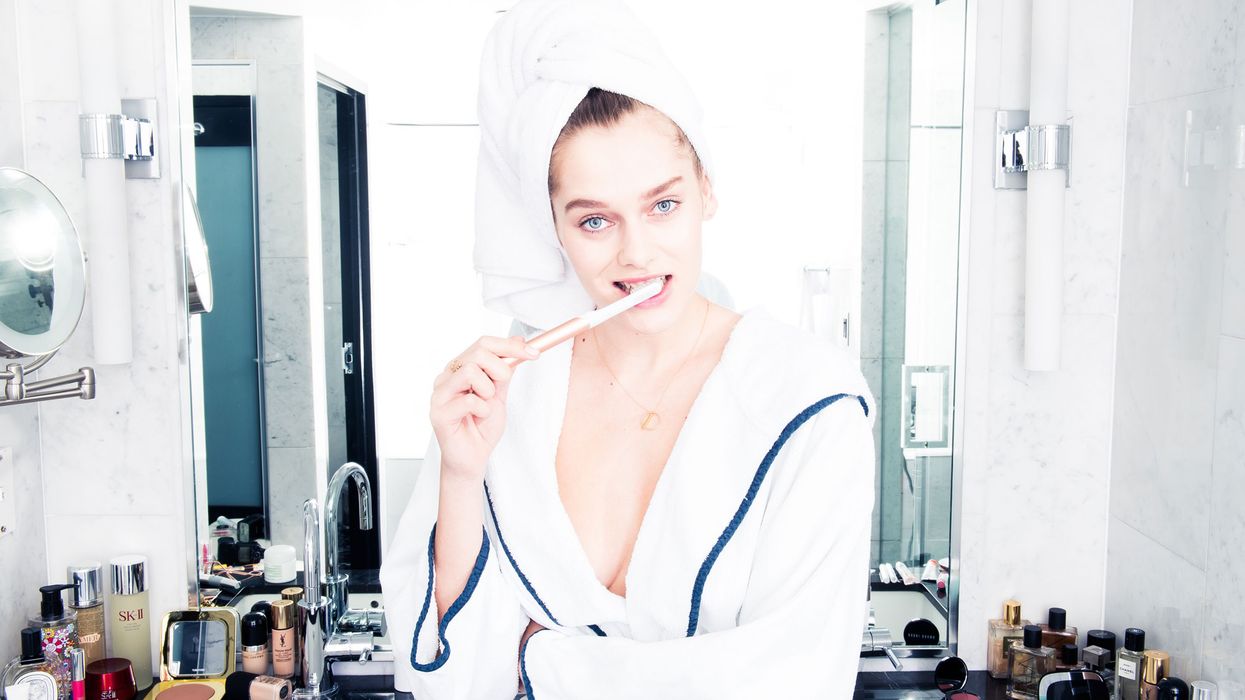Everything You Ever Wanted to Know about Natural Toothpaste
Say buh-bye morning breath, the all-natural way.

Toothpaste’s probably the most mundane, dare we say boring, beauty product in our bathroom. Which is pretty ironic considering a smile’s probably the first thing you notice about someone. Yet every time we run out, we mindlessly toss the same exact tube of peppermint stuff into our basket. But what if we told you you probably (aka really) should pay closer attention to the stuff you cleanse your pearly whites with?
Over the last few years, oral care has become much cleaner and greener, with brands promising brighter and whiter smile sans harmful ingredients. “As a dentist, I get hype when my patients buy into the idea of oral health because when people think of beauty and health, oral health is not at the forefront,” says dentist Dr. Elizabeth Fadoju. While no one is making a case for not using toothpaste since “lots of research has shown that toothpaste plays a major role in maintaining proper oral hygiene, it is worth considering the pros and cons of the traditional vs. natural stuff,” argues Dr. Rachel M. Potter. Keep reading to hear two professionals weigh in and learn which products are worth trying.
The Great Fluoride Debate…
Fluoride, a mineral found in many foods and even water, is the paraben/sulfate of the oral care industry. While it gets a pretty bad rap, a closer look reveals it’s a bit more complex than good or bad. “It helps with the remineralization of teeth and repairing the outer layer of enamel. Fluoride also helps reduce the risk of cavity formation and can help stop the early decay process. As with any product, with improper use, fluoride can be toxic or lead to abnormalities in developing dentition,” says Dr. Potter.
According to Dr. Fadoju, “The American Dental Association recommends an optimal fluoridation level of 0.7-1 parts per million, so any toothpaste with fluoride as an active ingredient is great.”
So why the anti-fluoride rumblings? Well, many believe it affects tissue in the body and can even disrupt the immune system. But to be clear, most of the debate surrounding fluoride pertains to the levels of the mineral in our water and not in the toothpaste we use.
Try Tom’s of Maine Whole Care Toothpaste in Cinnamon Clove ($3.99) for an ingredient-conscious toothpaste with a fluoride fix.
So What Exactly Should You Be Avoiding?
If your toothpaste includes Triclosan (an antiseptic additive sometimes used to help prevent gingivitis), microbeads (aka small plastic beads that are terrible for the environment), FD&C Blue (a dye produced from petroleum that gives toothpaste that shockingly aqua hue), or Sodium Lauryl Sulfate (aka SLS, a foaming agent that often times leads to canker sores), it’s probably a good idea to toss it.
Dr. Fadoju also advises to pay close attention to the RDA (Relative Abrasion) of your toothpaste. “Some dentists recommend an RDA value of 50 or less in abrasives. While some toothpastes can be quite effective, those who suffer from sensitive teeth need to be careful, as the abrasives in some toothpastes can make this worse.”
Davids Premium Natural Toothpaste ($8) sources 98% of its ingredients right here in the U.S. and is both sulfate- and fluoride-free.
Note: Both dentists agree that if you do decide to go fluoride-free, talk with your dentist about how you can receive fluoride in other ways such as supplements, water, or fluoride trays.
...And Tooth Powders?!?
You’ve probably spotted the earthy, crunchy type on your Instagram feed brushing their grill with tooth powders, also known as dental powders. Dating back to nearly the beginning of time, these powders are typically a mixture of baking soda and various herbs like cloves, mint, and cinnamon (you can even whip up your own batch!). While a tad messier and less convenient than a paste, some studies have shown that they can be more effective at removing plaque.
So when it comes to paste vs. powder, Dr. Potter believe “it depends on an individual’s personal preference. In general, the most important thing is to choose what’s appropriate for the oral condition of each individual, and brush properly twice daily.”
Combining traditional and contemporary wisdom, Fig+Yarrow’s Conrmint and Lavender Toothpowder ($14) is def worth a try. And for an ultra squeaky-clean, brush with the FOREO ISSA ($199).
Photo: Shot on site at 6 Columbus, a Sixty Hotel; On Solveig: Rings, Baker & Black, Azlee; Toothbrush, Quip; Hair, Angela Soto; Makeup, Andriani




